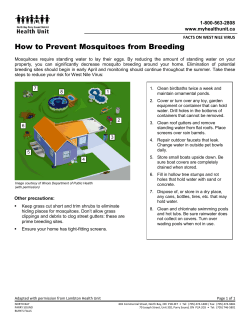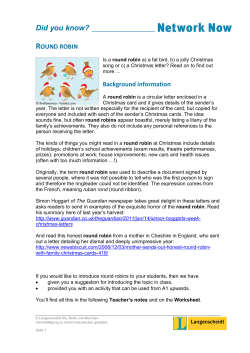
some notes on the breeding behaviour of the oriental magpie
Journal of Sustainability Science and Management Volume 9 Number 1, June 2014: 112-119 ISSN: 1823-8556 © Penerbit UMT SOME NOTES ON THE BREEDING BEHAVIOUR OF THE ORIENTAL MAGPIE ROBIN (COPSYCHUS SAULARIS) FROM UTTARAKHAND, INDIA DINESH BHATT*, VINAYA KUMAR SETHI, AMIT KUMAR AND AMAR SINGH Avian Diversity and Bioacoustics Lab., Department of Zoology and Environmental Science, Gurukula Kangri University, Haridwar- 249 404, Uttarakhand, India. *Corresponding author: dineshharidwar@gmail.com Abstract: In order to develop ornithological science, collection and interpretation of field data on different aspects of birds’ life are considered imperative. In this study, attempts have been made to understand the breeding behaviour of the Oriental Magpie Robin (Copsychus saularis), a tropical song bird. Observations were made on 27 pairs (of which 9 males and 16 females were ringed) during 2008-2010 in fruit orchards of district Haridwar, Uttarakhand, India. The observations revealed that the breeding season of the Oriental Magpie Robin ranged from March to August. The males delivered dawn chorus 38.2±9.1 minutes before sunrise during the breeding season. The males used continuous and discrete songs which seemed to play roles in inter- and intrasexual communication respectively. The bird nested in a variety of tree cavities such as Mango (Mangifera indica), Pear (Pyrus pyrifolia), Loquat (Eriobotrya japonica), Indian blackberry (Syzygium cumini), Kadamb (Neolamarckia cadamba), Mulberry (Morus alba) etc. The nest building was performed by female and the nest building period averaged 13.7±3.6 days. The clutch size averaged 4.8±0.8 eggs and the egg size and weight averaged 21.6 x 16.8 mm and 3.2±0.1 g respectively. The females developed the brood patch and incubated eggs for a mean of 12.4±0.5 days. Both sexes fed the young. Inter- and intra-specific fights for nesting cavities were common in the study area suggesting nest site scarcity for hole-nesting birds mainly due to habitat degradation. KEYWORDS: Breeding, clutch size, Copsychus saularis, incubation, Oriental Magpie Robin, song, tropical songbird. Introduction Studies on behavioural ecology of birds provide essential information in the field of evolutionary biology. Ornithology can develop and mature mainly by the collection and proper interpretation of real data collected in the field on different aspects of birds’ life (Nolan, 1978). The breeding characteristics of a species provide insights into the selection pressures that individuals of that species have faced over time. Long term and systematic data on the breeding ecology of previously unstudied species make it possible to conduct more rigorous comparative tests to determine what factors are responsible for the differences in breeding parameters between species (Dowling, 2003). The Oriental Magpie Robin (Copsychus saularis) (hereafter Magpie Robin) is a small passerine bird (7.5 inch long) that resides in 10.indd 112 tropical southern Asia from Bangladesh, interior India, Sri Lanka and eastern Pakistan east to Indonesia, Thailand, south China, Malaysia, Singapore and the Philippines. It is a common bird of urban gardens and forests and feeds on insects and other invertebrates. The male has black upperparts, head and throat apart from a white shoulder patch. The underparts and the sides of the long tail are white. The females are morphologically similar to the males except the black colour of male is replaced with grey colour in female (Ali & Ripley, 2001). Males of Magpie Robin are well known for their complex song delivery (Bhatt et al., 2000). The females have also been reported to sing briefly in the presence of male (Kumar & Bhatt, 2002). Other than songs, this species uses a range of different call types (Kumar & Bhatt, 2001). 5/26/14 10:51 AM SOME NOTES ON THE BREEDING BEHAVIOUR OF THE ORIENTAL MAGPIE ROBIN 113 The Magpie Robin is a secondary cavitynester that uses naturally occurring tree cavities for nesting (Ali & Ripley, 2001). As a general rule, populations of cavity nesters are often limited by the density of suitable nest sites (Newton 1998). Urbanization, a form of development is increasing worldwide and severely affecting local and global ecological systems (Marzluff, 2001; Imhoff et al., 2004). Cavity-nesting birds may be especially sensitive to urbanization because they depend on cavity bearing trees for nesting, roosting, and foraging (Thomas et al., 1976; Davis, 1983; Bull, et al., 1997). As per IUCN Red list category, the Magpie Robin is a ‘Least Concerned’ species globally and its population trend is stable (Birdlife International, 2013). However, in some areas this species is on the decline. For example, in Singapore and Hong Kong it was common in the 1920s, but declined in the 1970s, presumably due to poaching for the pet bird trade, loss of habitat and competition from introduced Common Mynas (Huong & Sodhi, 1997; Yap & Sodhi, 2004). The present study has been conducted in an area which has been undergoing rapid pace of urbanization through removal of orchards and agricultural lands for last few years. Furthermore, the fights between Magpie Robin and Common Myna over tree cavities for nesting are easy to observe in the study area (personal observation). Such circumstances could threaten the survival of the Magpie Robin in the study area. However, there exists no such information for Magpie Robin from India. Materials and Methods So far the breeding and general behaviour of the Magpie Robin is concerned, only few short notes exist on the habit, nest and feeding behaviour of this species (Hume, 1890; Bonnell, 1934; Pillai, 1956; Saxena, 1998) and detailed information on the breeding behaviour of this species are scanty. Keeping this background in view, this study aims to study some aspects of breeding behaviour of the Magpie Robin under natural conditions. Breeding Season and Singing Behaviour of the Male We observed the behavior of the 27 pairs of Magpie Robin during March to August in 20082010 in different fruit orchards situated within suburban habitat of district Haridwar (290 55’ N and 780 08’ E), Uttarakhand state, India. Out of 27 pairs, nine males and sixteen females were colour banded for individual recognition. Field visits were carried out generally on alternate days or as required during morning (0400 to 0700 hrs) and evening hours (1700 to 1900 hrs) for recording different breeding activities. Behaviours of individuals were observed mostly without disturbing the individuals using 10x50 field binoculars (Nikon Action EX) and still camera (Nikon FM 3A). The Sennheiser ME 67 directional microphone and Marantz PMD 670 portable solid state sound recorder were used for song recordings. Observations were made to record different breeding activities such as nest site selection, egg laying, incubation, parental provisioning, behaviour of young etc. Eggs were measured and weighed within 24 hours of laying. Clutch size was defined as the number of eggs laid by a female in single breeding attempt. Incubation period was considered as defined by Skutch (1945), to be the time elapsed between the laying of the last egg of the clutch and hatching of the last young. Results are reported as mean ± SD. Results and Discussion The breeding activities of the Magpie Robin commenced in late March and continued till August. The females started adding nesting material to nest site in the first week of April. Building of first nest started on 07 April, 14 April and 05 April in 2008, 2009 and 2010 respectively. The dates of laying of the first egg were 22 April, 24 April and 16 April respectively. The peak in breeding activity (availability of maximum clutches) in the Magpie Robin was observed in June during the study period as J. Sustain. Sci. Manage. Volume 9 (1) 2014: 112-119 10.indd 113 5/26/14 10:51 AM Dinesh Bhatt et al. on pooling the data of three years, maximum clutches (39%) were observed in the month of June. The first batch of nestlings fledged on 23 May, 29 May and 20 May in 2008, 2009 and 2010 respectively. The long breeding season of the Magpie Robin allowed breeding pairs to raise more than one brood. Ali and Ripley (2001) and Grimmett et al., (1998) have also reported almost the same length of breeding season of the Magpie Robin. The males Magpie Robin delivered complex songs mainly during the dawn throughout the breeding season. Dawn song delivery started 38.2±9.1 minutes (N=14) before sunrise. We observed males delivering two types of songs namely continuous songs and discrete songs. The males used continuous songs occasionally and mostly in the presence of the female. In contrast, discrete songs were delivered at any time of day throughout the breeding season with a maximum production during dawn. Dawn chorus, as observed in the Magpie Robin is a common feature of a number of song birds (Catchpole & Slater, 2008; Sethi et al., 2012). During dawn chorus, territorial male songbirds sing intensively within signaling range of several conspecific males (Sethi et al., 2011a). The more or less continuous singing over a long period of time under standardized stimulus conditions makes the dawn song a potentially important information source both for simple receivers and eavesdroppers (Poesel et al., 2004). Moreover, dawn appears to be the best time for singing because the hindrances to acoustic communication are least at this time of the day (Brown & Handford, 2003). The males delivered continuous songs in the proximity of female with expanded tail feathers (N=17). We observed mating also in the Magpie Robin immediately after the culmination of continuous song of the males (N=4). Such observations suggest that continuous songs in the Magpie Robin might play a role in female attraction. Many studies of female choice relative to song characteristics have focused on song complexity, and several studies have shown that song complexity plays a role in female mate 114 choice (Howard, 1974; Catchpole, 1980). Other studies have also examined the role of temporal characteristics of song in mate choice and an emerging theme from these previous studies is that females prefer longer songs (Moller et al., 1998; Catchpole & Slater, 2008). Discrete songs of the Magpie Robin seemed to play a role in intrasexual communication. The males delivered dawn chorus at or near territorial boundaries throughout the breeding season. During this study, the males trespassing into adjacent territories were immediately chased by the resident male and, shortly thereafter, both males began to sing. We frequently observed males interacting through counter-singing for extended periods, suggesting the importance of dawn songs for maintenance and adjustment of social relationship among neighbours. That is, males could use dawn singing to communicate with other males, to announce and assess their strength or willingness to defend the territory, or to challenge neighbours on a daily basis throughout the breeding season, as reported in social dynamic hypothesis by Staicer et al. (1996) and has been supported by some studies (see Sethi et al., 2011b). Characteristics of Nest Sites The Magpie Robin is a secondary cavity nester species and nested in a variety of tree cavities such as Mango (Mangifera indica), Pear (Pyrus pyrifolia), Loquat (Eriobotrya japonica), Indian blackberry (Syzygium cumini), Kadamb (Neolamarckia cadamba), Mulberry (Morus alba) etc. We measured the characteristics of thirty seven natural cavities and different parameters averaged as follows: cavity height (from the ground) = 209.3±72.0 cm. (range 68365 cm.), cavity length = 13.9±3.0 cm. (range 4-17 cm.), cavity width= 11.3±2.9 cm. (range 10-23 cm.) and cavity depth = 24.1±6.2 cm. (range 12-33 cm.). We frequently observed pairs of the Magpie Robin fighting for nest cavities. In a number of instances (N=16), we observed two or more pairs fighting for a single cavity that caused considerable delay in the initiation of J. Sustain. Sci. Manage. Volume 9 (1) 2014: 112-119 10.indd 114 5/26/14 10:51 AM SOME NOTES ON THE BREEDING BEHAVIOUR OF THE ORIENTAL MAGPIE ROBIN breeding activities such as nest building. In an instance, two pairs were observed continuously fighting for a cavity for more than two months (May-June) and none of them could occupy it because eventually a pair of Common Myna (Acridotheres tristis) boldly selected this cavity for nesting. Frequent fighting among pairs indicates the scarcity of cavities for nesting in the study area. This may be explained with the reason that the study area has been facing large scale urbanization for the last few years, where orchards and agricultural lands are being converted into concrete residential human settlements. Availability of cavity bearing trees has been observed closely tied to fitness of the hole nesting birds (Martin & Roper, 1988). Moreover, interspecific conflict for cavities, as observed in this study, has been identified as an important aspect affecting breeding success and population status of cavity nesting bird species (Pell & Tidemann, 1997). We observed the Common Myna being dominant user of available nest cavities. In most of the encounters observed between the Magpie Robin and the Common Myna pairs (N=11), the Common Myna was mostly successful in cavity occupancy (N=10). Such incidence could force the Magpie Robin to opt suboptimal sites for breeding, however, we did not work on this aspect. In a study conducted in eastern Australia, Pell & Tidemann (1997) have found strong evidence that the exotic myna species had the potential to reduce the breeding success of the native parrot species. The loss of orchards and scattered trees patches coupled with fighting among pairs for nest sites in our study area appears an early warning to the human race regarding possible decline in the population of a number of species including the Magpie Robin in near future. Nest Site Selection In the Magpie Robin, nest-site selection was performed by both the sexes. Mostly male initiated exploring the whole territory and inspected various cavities or depressions within 115 territories repeatedly. Thereafter, he restricted his activities to any specific cavity and explored it more thoroughly. Then he approached the female to show her the sites for final selection. The duration of nest site selection process ranged from 9 to 22 days with a mean duration of 14.7±3.7 days. Only the females performed the nest building in the Magpie Robin. The nest building period averaged 13.7±3.6 days (N=5). All the pairs attempted to raise second/third brood in a single breeding season used the nest of first brood. Like the Magpie Robin, in other bird species also, male typically displays at several nest sites, one of which is finally selected by female and only female builds the nest (Aguon & Conant, 1994; Oliarnyk & Robertson, 1996; Kumar, 2010). Clutch Size and Egg Characteristics Clutch size in the Magpie Robin ranged from 3-6 eggs with a mean value of 4.8±0.8 eggs (N= 38 laying attempts). Most nests (57.9%) had clutch of 5 eggs followed by 4 (28.9%), 6 (7.9%) and 3 (5.3%) eggs. Our results for clutch size are comparable with the existing literature. Ali and Ripley (2001) have also reported the clutch size varying from 3-6 eggs for the Magpie Robin with 3 being an occasional number of eggs in a clutch. Eggs of the Magpie Robin were pale green, profusely blotched with reddish brown with underline marks of purple-grey. The weight of 38 eggs averaged 3.2±0.1 g. The average size of 38 eggs was observed 21.61x16.85 mm which was found relatively smaller as reported elsewhere (21.9x17.1 mm) for the Magpie Robin (see Ali & Ripley, 2001). Incubation Behavior In the Magpie Robin, one egg was laid each day with incubation commencing after but on the same day when the last egg was laid. On 84 occasions (in 27 nesting attempts) on which sitting birds were flushed from nest during morning (n= 68) or evening hours (n= 16), all were females confirming that only females incubate in the Magpie Robin. When female was in the nest, male mostly remained in the vicinity J. Sustain. Sci. Manage. Volume 9 (1) 2014: 112-119 10.indd 115 5/26/14 10:51 AM Dinesh Bhatt et al. of the nest. The incubation period ranged from 12-14 days with a mean value of 12.4±0.5 days (N = 17). 116 The eggs of the Magpie Robin hatched on the same day in almost all the cases (N= 16). However, in two cases hatching of the entire clutch extended up to 40 hours. The newly hatched orange-brown young were with closedeyes and almost naked. The females removed the egg shell from the nest immediately after hatching and dropped it far from the nest (N=9). Nestlings responded to the parental provisioning/feeding calls or arrival cues by gapping and exposing a bright yellow target in their mouths. Altricial nestlings of the Magpie Robin were solely dependent on their parents for provisioning and protection. In order to be fed by the parents, nestlings used soft begging calls almost throughout the day from nests. Physical characteristics of the begging call of nestling of the Magpie Robin have already been studied (Kumar & Bhatt, 2001). broods that beg more intensely may suffer increased predation risk (Dearborn, 1999). If begging calls attract the predators towards nest, it seems necessary to trade off the nutritional benefits of begging call against the cost of predation (Maurer et al., 2003). Parents could reduce this cost through warning noisy chicks of danger so that they do not vocalize when predators are near (Platzen & Magrath, 2004). There are evidence through playback studies conducted by Ryden (1978) and Greig-Smith (1980) who showed that Great tit (Parus major) and Stonechat (Saxicola torquata) nestlings, respectively, suppressed begging after hearing playbacks of alarm calls. Nestling American goldfinches (Carduelis tristis) also crouch into the nest upon hearing the alarm calls (Knight & Temple, 1986). Platzen & Magrath (2004), through a field playback experiment, have also suggested that parental alarm calls can warn young from a distance about the presence of a predator and as a result nestling White-browed scrubwren (Sericornis frontalis) suppress begging vocalization that might otherwise be overheard. However, contrary to these studies, parental alarm calls in the Magpie Robin did not cause the nestlings to become quiet and crouch in the nest (N= 24). Moreover, they continued to beg even when the parents were giving alarm calls and observer (one of us) was within 1-2 m from the nest. This suggests that parents either direct their alarm call to predators to lead them away from the nest or nestlings might not have ability to respond to parental alarm calls. According to Maurer et al., (2003) nestlings Scrubwren (Sericornis frontalis) acquire the ability to respond appropriately to alarm calls late in the nestling period. The loud and rapid begging calls of nestling birds signal their hunger and stimulate parental provisioning (Kilner et al., 1999). Parents generally respond to begging calls by directing feeding to the most intensively begging nestling in their brood (Kolliker et al., 1998) or by increasing their provisioning rate to the brood as a whole (Ottoson et al., 1997). However, these conspicuous calls of nestlings can also attract predators to the nest and consequently Soon after hatching the parents started feeding the young quite consistently. Initially for about 4 days of hatching the young remained almost silent in the nest and responded to the parental arrival just by opening their beak. However, in later phase they started producing begging calls. Like the Magpie Robin, several avian species exhibit biparental provisioning to the young (see Sethi et al., 2010). Our previous observations have indicated that female Magpie During this study, the females were observed possessing brood patch (N=23) and none of the male developed brood patch in the Magpie Robin (N=11). Brood patch was unmistakably observed in all the females, however, strictly during incubation and pre-nestling phases of the breeding season. Like the Magpie Robin, most bird species develop brood patches during the breeding season on the ventral thoracic and/or the abdominal region of the body. However, the number, placement and development time of the brood patches vary widely across avian taxa (Jones, 1971). Behavior of Nestlings and Fledglings J. Sustain. Sci. Manage. Volume 9 (1) 2014: 112-119 10.indd 116 5/26/14 10:51 AM SOME NOTES ON THE BREEDING BEHAVIOUR OF THE ORIENTAL MAGPIE ROBIN Robin feeds the young more than male and nestlings are significantly fed more as they become older, however, brood size and time of day do not affect the rate of parental provisioning (Sethi & Bhatt, 2007). The nestling period i.e. time lapsed between hatching of the first young and fledging of all young in nest, in the Magpie Robin ranged from 13-16 days with a mean value of 14.72±0.55 days (N=23 nests). Different factors with varying rates caused loss of young in the Magpie Robin (manuscript under preparation). When normal and healthy nestlings were found missing from the nest, it was considered a case of predation that caused considerable loss of young in Magpie Robin. It was difficult to witness the actual act of predation except for two instances (N=2 nests) where snakes (unidentified species) were observed feeding on the nestlings of the Magpie Robin. Dead nestlings were also found in the nest and their death seemed to be caused by some disease or infection. Nest destruction also caused loss of young in the Magpie Robin. Nest destruction was caused by the rainwater flow in the cavity or by human activities. Human activities mostly included cutting of cavity (nest) bearing tree. Young of the Magpie Robin remained dependent on parents for provisioning and safety at least for twenty days (N=12). Thereafter, they started to catch the insects to feed. In a nut shell, the breeding season of the Magpie Robin extended from March to August. During breeding season males delivered complex songs during dawn. Nest site selection was performed by both the sexes. However, nest building and incubation duties were performed only by female. Clutch size in the Magpie Robin ranged from 3-6 eggs. Young delivered loud calls to solicit parental provisioning. Inter- and intraspecific fights for nesting cavities were common in the Magpie Robin. Such fights were linked to the nest site shortage for birds in the study area due to habitat destruction for urbanization. Observations suggest that the loss of habitat may threaten the existence of the Magpie Robin and other secondary cavity nesting birds sooner or later and thus, appropriate conservations 117 measures such as planned urbanization, nailing of artificial nest boxes should be addressed and implemented. Acknowledgements We thank the Head, Department of Zoology & Environmental Science, Gurukula Kangri University, Haridwar, India for providing infrastructural facilities to carry out this research. Many thanks to Mr. Shivchand Arora for assistance in the field. Authors are grateful to Swami Shivananda Ji, Matri Sadan, Jagjeetpur, Haridwar, India for giving his kind consent to conduct a part of this study in his premises. References Aguon, C. F., & Conant S. (1994). Breeding Biology of the White-rumped Shama on Oahu, Hawaii. Wilson Bulletin, 106: 311328. Ali, S., & Ripley, S. D. (2001). Handbook of the Birds of India and Pakistan, (9). New Delhi: Oxford University Press, Bhatt, D., Kumar, A., Singh, Y., & Payne, R. B. (2000). Territorial Songs and Calls of the Oriental Magpie Robin Copsychus saularis. Current Science, 78: 722-728. BirdLife International. (2013). Species Factsheet: Copsychus saularis. Downloaded from http://www.birdlife. org on 22/08/2013. Bonnell, B. (1934). Notes on the Habits of the Magpie Robin Copsychus saularis saularis Linn. Journal of Bombay Natural History Society, 37: 729-730. Brown, T. J., & Handford, P. (2003). Why Birds Sing at Dawn: The Role of Consistent Song Transmission. Ibis, 145: 120-129. Bull, E. L., Parks, C. G., & Torgerson, T. R. (1997). Trees and Logs Important to Wildlife in the Interior Columbia River basin. USDA Forest Service General Technical Report, PNW–GTR- 391. Pacific Northwest Research Station. Portland. Oregon. J. Sustain. Sci. Manage. Volume 9 (1) 2014: 112-119 10.indd 117 5/26/14 10:51 AM Dinesh Bhatt et al. Catchpole, C. K. (1980). Sexual Selection and the Evolution of Complex Songs among European Warblers of the Genus Acrocephalus. Behaviour, 74: 149-166. Catchpole, C. K., & Slater, P. J. B. (2008). Bird song-Biological Themes and Variations. Cambridge: Cambridge University Press. Davis, J. S. (1983). Snags are for Wildlife. Snag Habitat Management: Proceedings of a Symposium. U.S. Forest Service General Technical Report RM-99: 4-9. Dearborn, D. C. (1999). Brown-headed Cowbird Nestling Vocalization and Risk of Nest Predation. Auk, 116: 448-457. Dowling, D. K. (2003). Breeding Biology of the Red-capped Robin. Australian Journal of Zoology, 51: 533-549. Greig-Smith, P. W. (1980). Parental Investment in Nest Defense by Stonechats (Saxicola torquata). Animal Behaviour, 28: 604-619. Grimmett, R., Inskipp, C., & Inskipp, T. (1998). Birds of the Indian Subcontinent. New Delhi: Oxford University Press. Howard, R. D. (1974). The Influence of Sexual Selection and Interspecific Competition on Mockingbird Song (Mimus polyglottos). Evolution, 28: 428-438. Hume, A. O. (1890). The Nests and Eggs of Indian Birds, 2nd ed., London: R. H. Porter. 80-85. Huong, S. L., & Sodhi, N. S. (1997). Status of the Oriental Magpie Robin Copsychus saularis in Singapore. Malayan Nature Journal, 50: 347-354. Imhoff, M. L., Bounoua, L., DeFries, R., Lawrence, W. T., Stutzer, D., Tucker, C. J., & Ricketts,T. (2004). The Consequences of Urban Land Transformation on Net Primary Productivity in the United States. Remote Sensing of Environment, 89: 434-443. Jones, R. E. (1971). The Incubation Patch of Birds. Biological Reviews, 46: 315-339. Kilner, R. M., Noble, D. G., & Davies, N. B. (1999). Signals of Need in Parent-offspring Communication and Their Exploitation by 118 the Common Cuckoo. Nature, 397: 667672. Knight, R. L., & Temple, S. A. (1986). Why Does Intensity of Avian Nest Defense Increase during the Nesting cycle? Auk, 103: 318-327. Kolliker, M., Richner, H., Werner, I., & Hebb, P. (1998). Begging Signals and Biparental Care: Nestling Choice between Parental Feeding Locations. Animal Behaviour, 55: 215-222. Kumar, A., & Bhatt, D. (2001). Characteristics and Significance of Calls in Oriental Magpie robin. Current Science, 80: 77-82. Kumar, A., & Bhatt, D. (2002). Characteristics and Significance of Song in Female Oriental Magpie Robin Copsychus saularis. Journal of Bombay Natural History Society, 99: 5458. Kumar, A. (2010). Breeding Biology of Pied Bush Chat Saxicola caprata with Reference to the Contextual Analysis of its Acoustic Signals, Ph.D. Dissertation. Gurukula Kangri University, Haridwar, India. Martin, T. E., & Roper, J. J. (1988). Nest Predation and Nest Site Selection of a Western Population of the Hermit Thrush. Condor, 90: 5l-57. Marzluff, J. M. (2001). Worldwide Urbanisation and its Effects on Birds. In: Avian Ecology and Conservation in an Urbanizing World (Eds. Marzluff, J. M., Bowman, R., & Donnelly, R.). 19-47. Boston: Kluwer Academic Publishers. Maurer, G., Magrath, R. D., Leonard, M. L., Horn, A. G., & Donnelly, C. (2003). Begging to Differ: Scrubwren Nestlings Beg to Alarm Calls and Vocalize When Parents are Absent. Animal Behaviour, 65: 1045-1055. Moller, A. P., Saino, N., Taromino, G., Galeotti, P., & Ferrario, S. (1998). Paternity and Multiple Signaling: Effects of Secondary Sexual Character and Song on Paternity in the Barn Swallow. American Naturalists, 151: 236-242. J. Sustain. Sci. Manage. Volume 9 (1) 2014: 112-119 10.indd 118 5/26/14 10:51 AM SOME NOTES ON THE BREEDING BEHAVIOUR OF THE ORIENTAL MAGPIE ROBIN Newton, I. (1998). Population Limitation in Birds. London: Academic Press. Nolan Jr., V. (1978). Ecology and Behavior of the Prairie Warbler Dendroica discolor. Ornithological Monographs, 26: 1-595. Oliarnyk, C. J., & Robertson, R. J. (1996). Breeding Behaviour and Reproductive Success of Cerulean Warblers in Southeastern Ontario. Wilson Bulletin, 108: 673-684. Ottoson, U., Backmann, J., & Smith, H. G. (1997). Begging Affects Parental Efforts in the Pied Flycatchers, Ficedula hypoleuca. Behavioral Ecology Sociobiology, 41: 381384. Pell, A. S., & Tidemann, C. R. (1997). The Impact of Two Exotic Hollow Nesting Birds on Two Native Parrots in Savannah and Woodland in Eastern Australia. Biological Conservation, 79: 145-153. Pillai, N. G. (1956). Incubation Period and Mortality Rate in a Brood of the MagpieRobin [Copsychus saularis (Linn.)]. Journal of Bombay Natural History Society, 54: 182-183. Platzen, D., & Magrath, R. D. (2004). Parental Alarm Calls Suppress Nestling Vocalization. Proceedings of Royal Society, London B, 271: 1271-1276. Poesel, A., Dabelsteen, T., & Pedersen, S. B. (2004). Dawn Song of Male Blue Tits as a Predictor of Competitiveness in Midmorning Singing Interactions. Acta Ethologica, 6: 65-71. Ryden, O. (1978). Differential Responsiveness of Great Tit Nestlings, Parus Major to Natural Auditory Stimuli—Response Strength as Related to Stimulus Significance and Previous Individual Exposure. Zeitschrift für Tierpsychologie, 47: 236-253. Saxena, R. (1998). Geckos as Food of Magpie Robin. Journal of Bombay Natural History Society, 95: 347. 119 Sethi, V. K., & Bhatt, D. (2007). Provisioning of Young by the Oriental Magpie-robin (Copsychcus saularis). Wilson Journal of Ornithology, 119: 356-360. Sethi, V. K., Bhatt, D., & Kumar, A. (2010). On the Patterns of Parental Provisioning by the Purple Sunbird Nectarinia asiatica. Sunbird, 40: 39-47. Sethi, V. K., Bhatt, D., & Kumar, A. (2011a). Song Repertoire Size of the Pied Bush Chat Saxicola caprata. Current Science, 100: 302-304. Sethi, V. K., Bhatt, D., & Kumar, A. (2011b). The Effect of Mate Removal on Dawn Singing Behaviour in Male Pied Bush Chats. Current Zoology, 57: 72-76. Sethi, V. K., Bhatt, D., & Kumar, A. (2012). Dawn Singing Behaviour of Pied Bush Chat Saxicola caprata. Journal of Applied and Natural Science, 4: 241-246. Skutch, A. F. (1945). Incubation and Nestling Periods of Central American birds. Auk, 62: 8-37. Staicer, C. A., Spector, D. A., & Horn, A. G. (1996). The Dawn Chorus And Other Diel Patterns in Acoustic Signaling. In: Ecology and Evolution of Acoustic Communication in Birds (Eds. Kroodsma, D. E., & Miller, E. H.), 426-453, Ithaca: Cornell University Press. Thomas, J. W., Miller, R. J., Black, H., Rodiek, J. E., & Maser, C. (1976). Guidelines for Maintaining and Enhancing Wildlife Habitat in Forest Management in the Blue Mountains of Oregon and Washington. Trans. North American Wildlife and Natural Resources Conference, 41: 452-476. Yap, C. A. M., & Sodhi, N. S. (2004). Southeast Asian Invasive Birds: Ecology, Impact and Management. Ornithological Science, 3: 57-67. J. Sustain. Sci. Manage. Volume 9 (1) 2014: 112-119 10.indd 119 5/26/14 10:51 AM
© Copyright 2025









